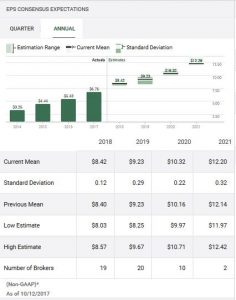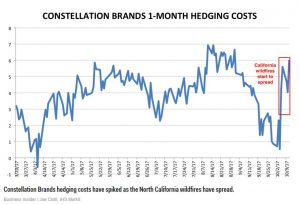Contents
 Summary
Summary
- This Constellation Brands Stock Analysis is based on Q2 2018 results released October 5, 2017.
- Constellation Brands has certainly rewarded long-time shareholders.
- As an investor who currently has no position in the company I view the current valuation to be too rich to initiate a position.
- The company released its Q2 2018 results at the beginning of October 2017. FCF projections and the current number of shares outstanding suggest the Share Price/FCF ratio is well above historical levels.
- We are several years into a bull market. I suspect many investors have never experienced a dramatic market correction subsequent to becoming a self-directed investor.
- Complacency appears to be the mindset of many an investor. I suspect geopolitical risks of the like we have not experienced in many years are being taken lightly.
Introduction
Long-time Constellation Brands (NYSE: STZ) shareholders certainly have a lot to smile about. One look at this stock chart will explain why.
On October 5, 2017, STZ released its Q2 2018 results. Given the recent earnings announcement I thought I would look into whether I should acquire STZ shares either for the FFJ Portfolio or for one of our other accounts for which I do not publicly disclose information.
Business Overview
STZ has morphed into a leading international producer and marketer of beer, wine and spirits with operations in the U.S., Mexico, New Zealand and Italy.
In 1945, Marvin Sands formed the Canandaigua Industries Company; he was only 21 years old! It certainly was humble beginnings as the company had only eight employees and the sale of bulk wine in barrels to bottlers in the East only amounted to approximately 200,000 gallons or $150,000.
Readers interested in learning how STZ evolved into a company whose annual revenue is fast approaching $8B can learn about STZ’s heritage here.
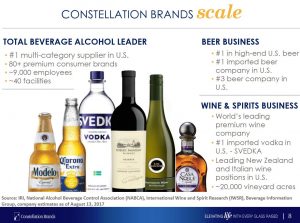 (Source: STZ Q2 2018 presentation)
(Source: STZ Q2 2018 presentation)
STZ’s wine, beer, spirits, and specialty beverages brands can be viewed here. I also strongly suggest a review of STZ’s detailed Q2 2018 Investor Presentation.
Q2 2018 Results and Forecast
On October 5, 2017, STZ released its Q2 2018 results and provided guidance for the remainder of the current fiscal year.
Results were provided on a reported basis and a comparable basis. The reason for this is that STZ divested itself of its Canadian operations in December 2016 when it completed the sale of the Canadian wine business to Ontario Teachers’ Pension Plan. This transaction included Canadian wine brands such as Jackson-Triggs and Inniskillin, wineries, vineyards, offices, facilities, and Wine Rack retail stores. The value of this business was ~ C$1.03B; STZ received cash proceeds, net of repayment of outstanding debt, of approximately C$0.765B.
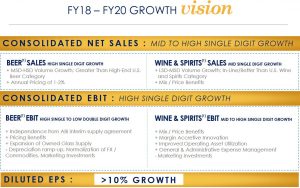 (Source: STZ Q2 2018 presentation)
(Source: STZ Q2 2018 presentation)
Free Cash Flow
I view Free Cash Flow as a critical measure of a company’s financial performance. By taking operating cash flow minus capital expenditures, I am able to determine the cash a company is able to generate after spending money required to maintain or expand its asset base.
Reported earnings per share (EPS), on the other hand, can be manipulated by management thus distorting the Price Earnings ratio.
In this regard, I thought I would take a look at STZ’s historical and current Free Cash Flow relative to its stock price.
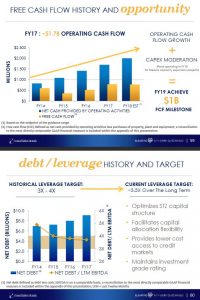 (Source: STZ Q2 2018 presentation)
(Source: STZ Q2 2018 presentation)
![]() As at Q2 2018, STZ had a weighted average of 201.346 million shares outstanding on a diluted basis. Free Cash Flow of $725 – $825 million is projected for the year. Using this range and the weighted average number of diluted shares outstanding reflected above, I get a projected Free Cash Flow per share range of $3.60 – $4.1.
As at Q2 2018, STZ had a weighted average of 201.346 million shares outstanding on a diluted basis. Free Cash Flow of $725 – $825 million is projected for the year. Using this range and the weighted average number of diluted shares outstanding reflected above, I get a projected Free Cash Flow per share range of $3.60 – $4.1.
If I use the current stock price of $208.56 and my projected Free Cash Flow per share range, I get a Stock Price/Free Cash Flow ratio range of 50.87 – 57.93. This level is exceedingly high relative to historical levels (excluding fiscal 2015).
Dividends, Dividend Growth, and Stock Repurchases
STZ has historically been a non-dividend payer. This all changed in April 2015 when STZ’s Board of Directors approved the initiation of a dividend program under which the company intends to pay a regular quarterly cash dividend to stockholders of its common stock.
Readers interested in acquiring STZ shares should be aware that there are different classes of shares and different voting privileges.
The quarterly dividend for the commonly held Class A Common Stock is slightly higher than that for the thinly traded Class B Common Stock (currently $0.52 versus $0.47 per share).
The Class B Common Stock is principally held by members of the Sands family, either directly or through entities controlled by members of the Sands family.
There is also a Class 1 Common Stock but there is no public trading market for this class of shares. The cash dividends declared for the Class 1 Common Stock are the same as those declared for the Class B Common Stock.
Holders of Class A Common Stock are entitled to 1 vote per share and holders of Class B Common Stock are entitled to 10 votes per share; holders of Class 1 Common Stock generally do not have voting rights. The stock ownership of the Sands family and entities controlled by members of the Sands family represents a majority of the combined voting power of all classes of STZ’s common stock. As a result, the Sands family has the power to elect a majority of the directors and approve actions requiring the approval of the stockholders of the Company.
Personally, I am not concerned about the different classes of shares and voting rights. I am fully confident the controlling shareholders are operating STZ in the best interests of all shareholders.
I see no reason why investors should have any concern about STZ’s ability to service its dividend commitments; I recognize these are not mandatory payments. Free Cash Flow is strong and the dividend payout ratio is very conservative at ~23%.
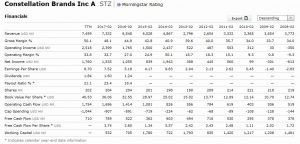 (Source: Morningstar)
(Source: Morningstar)
Based on STZ’s recent dividend history, I suspect investors can realistically expect another $0.52/share dividend in February 2018 (the November 7, 2017 $0.52/share dividend was declared October 4, 2017) followed by possibly a 7 – 10% increase come the April 2018 dividend declaration date.
One of STZ’s cash priorities is a 25 – 35% dividend payout ratio.
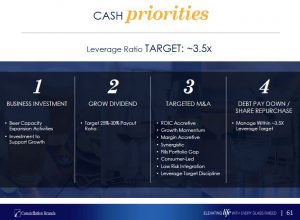 (Source: STZ Q2 2018 presentation)
(Source: STZ Q2 2018 presentation)
If EPS of ~$8.42 is projected, then a 30% payout ratio would be $2.53. This represents a ~22% increase from the current annual $2.08 dividend; this increase is slightly less than previous increases.
Valuation
The current mean EPS estimate for fiscal 2018 from 19 brokers is $8.42 with the low and high estimates being $8.03 and $8.57.
Using the current stock price of $208.56 and the mean EPS estimate of $8.42, we arrive at a PE of 24.75. This is slightly lower than the PE ratio of 26.68 reported on Google Finance.
As previously noted in this post, I like to look at a company’s stock price relative to Free Cash Flow.
I certainly do not expect STZ’s stock price to Free Cash Flow ratio to return to levels exhibited in 2008 – 2010 as the STZ of today is very different from the STZ during that period. Furthermore, we experienced a Financial Crisis during that timeframe.
In my opinion, a Stock Price to Free Cash Flow per share around 40 for a growing company like STZ is reasonable. This ratio can vary by company and is dependent on several factors of which industry and growth potential are a couple of factors to consider.
Using my projected free cash flow estimate of $3.85 (mid-point of my $3.60 – $4.10 Free Cash Flow per share range) we get a price of ~$154.00. Unless we encounter another Financial Crisis I suspect STZ will not revisit this level so let’s go with $4.10 which is the upper end of the range. If I use a multiple of 40 times then my stock price entry point is $164.
This would represent a ~20% drop from the current price of $208.56. Looking at STZ’s stock chart, this may not be totally unreasonable as STZ was trading at this level in March 2017 before the sudden run-up in price.
California Fires
I would be remiss if I were to exclude any mention of the fires that are devastating many wineries in California and the impact this may have on STZ.
STZ operates 18 different wineries in California. I am aware that it has shut down its tasting rooms in the Napa Valley and Sonoma but I have been unable to locate specific details as to the extent of any damage to STZ’s facilities; I see no reference to this matter on the company’s website.
I suspected traders would be concerned about the impact of this calamity on STZ and other operators in these California regions. Sure enough, there has been a recent surge in hedging costs. There has been a spike in the cost of options protecting against a 10% decline over the next month relative to bets on a 10% increase.
(Source: Business Insider)
Should STZ have experienced significant damage to its California wine operations, it is entirely possible the cost of replacing the damaged operations could be substantial. I draw to your attention page 20 of 126 in STZ’s 2017 10K under the heading “Catastrophic loss to wineries, production facilities or distribution systems”.
A similar risk lies with STZ’s “Supply of Mexican beer brands”. Page 18 of the 10K indicates “our general insurance policies may not cover certain types of catastrophes that might affect our supply of the Mexican beer brands. A major uninsured catastrophe could result in significant unrecoverable losses.
It is possible the fires in California could result in a shift in investor sentiment from positive to negative. The extent to which this plays out on STZ’s stock price remains to be seen but I suspect it will be minimal. Judging from the image above, however, traders are not taking any chances.
Constellation Brands Stock Analysis – Final Thoughts
STZ is a wonderful company. A wonderful company, however, does not necessarily always make for a wonderful investment.
I see enough similarities between the current state of market euphoria to similar prior periods to suggest many investors have become complacent. We have been in a very long bull market and I suspect many relatively “new investors” have not experienced any significant market correction since becoming a self-directed investor; I define “new investors” as investors who actively started investing in equities after the Financial Crisis.
In addition, I see geopolitical risks unlike those experienced in many years. I recognize we have long had to contend with issues in North Korea, Russia, and the Middle East. This time, however, we also have to contend with someone in the White House whose behavior raises eyebrows.
For those of you who had the foresight to invest in STZ many, many years ago….congratulations! You have hit one out of the park and I am happy for you.
For those of you, like me, who invested in other companies and not STZ, I strongly suspect now is not the greatest time to initiate a position.
I wish you much success on your journey to financial freedom.
Thanks for reading!
Note: I sincerely appreciate the time you took to read this post. As always, please leave any feedback and questions you may have in the “Contact Me Here” section to the right.
Disclaimer: I have no knowledge of your individual circumstances and am not providing individualized advice or recommendations. I encourage you not to make any investment decision without conducting your own research and due diligence. You should also consult your financial advisor about your specific situation.
Disclosure: I currently do not hold a position in STZ and have no intention of initiating a position within the next 72 hours.
I wrote this article myself and it expresses my own opinions. I am not receiving compensation for it and have no business relationship with any company whose stock is mentioned in this article.


